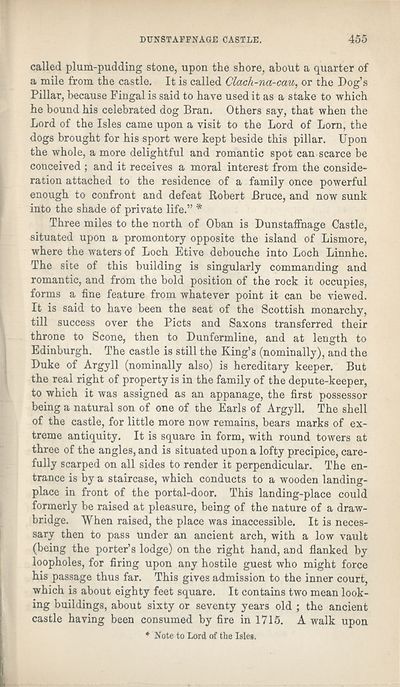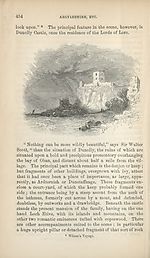Download files
Complete book:
Individual page:
Thumbnail gallery: Grid view | List view

DUNSTAFFNAGE CASTLE.
455
called plum-pudding stone, upon the shore, about a quarter of
a mile from the castle. It is called Clach-na-cau, or the Dog’s
Pillar, because Fingal is said to have used it as a stake to which
he bound his celebrated dog Bran. Others say, that when the
Lord of the Isles came upon a visit to the Lord of Lorn, the
dogs brought for his sport were kept beside this pillar. Upon
the whole, a more delightful and romantic spot can scarce be
conceived ; and it receives a moral interest from the conside¬
ration attached to the residence of a family once powerful
enough to confront and defeat Robert Bruce, and now sunk
into the shade of private life.” *
Three miles to the north of Oban is Dunstaffnage Castle,
situated upon a promontory opposite the island of Lismore,
where the waters of Loch Etive debouche into Loch Linnhe.
The site of this building is singularly commanding and
romantic, and from the bold position of the rock it occupies,
forms a fine feature from whatever point it can be viewed.
It is said to have been the seat of the Scottish monarchy,
till success over the Piets and Saxons transferred their
throne to Scone, then to Dunfermline, and at length to
Edinburgh. The castle is still the King’s (nominally), and the
Duke of Argyll (nominally also) is hereditary keeper. But
the real right of property is in the family of the depute-keeper,
to which it was assigned as an appanage, the first possessor
being a natural son of one of the Earls of Argyll. The shell
of the castle, for little more now remains, bears marks of ex¬
treme antiquity. It is square in form, with round towers at
three of the angles, and is situated upon a lofty precipice, care¬
fully scarped on all sides to render it perpendicular. The en¬
trance is by a staircase, which conducts to a wooden landing-
place in front of the portal-door. This landing-place could
formerly be raised at pleasure, being of the nature of a draw¬
bridge. When raised, the place was inaccessible. It is neces¬
sary then to pass under an ancient arch, with a low vault
(being the porter’s lodge) on the right hand, and flanked by
loopholes, for firing upon any hostile guest who might force
his passage thus far. This gives admission to the inner court,
which is about eighty feet square. It contains two mean look¬
ing buildings, about sixty or seventy years old ; the ancient
castle having been consumed by fire in 1715. A walk upon
* Note to Lord of the Isles.
455
called plum-pudding stone, upon the shore, about a quarter of
a mile from the castle. It is called Clach-na-cau, or the Dog’s
Pillar, because Fingal is said to have used it as a stake to which
he bound his celebrated dog Bran. Others say, that when the
Lord of the Isles came upon a visit to the Lord of Lorn, the
dogs brought for his sport were kept beside this pillar. Upon
the whole, a more delightful and romantic spot can scarce be
conceived ; and it receives a moral interest from the conside¬
ration attached to the residence of a family once powerful
enough to confront and defeat Robert Bruce, and now sunk
into the shade of private life.” *
Three miles to the north of Oban is Dunstaffnage Castle,
situated upon a promontory opposite the island of Lismore,
where the waters of Loch Etive debouche into Loch Linnhe.
The site of this building is singularly commanding and
romantic, and from the bold position of the rock it occupies,
forms a fine feature from whatever point it can be viewed.
It is said to have been the seat of the Scottish monarchy,
till success over the Piets and Saxons transferred their
throne to Scone, then to Dunfermline, and at length to
Edinburgh. The castle is still the King’s (nominally), and the
Duke of Argyll (nominally also) is hereditary keeper. But
the real right of property is in the family of the depute-keeper,
to which it was assigned as an appanage, the first possessor
being a natural son of one of the Earls of Argyll. The shell
of the castle, for little more now remains, bears marks of ex¬
treme antiquity. It is square in form, with round towers at
three of the angles, and is situated upon a lofty precipice, care¬
fully scarped on all sides to render it perpendicular. The en¬
trance is by a staircase, which conducts to a wooden landing-
place in front of the portal-door. This landing-place could
formerly be raised at pleasure, being of the nature of a draw¬
bridge. When raised, the place was inaccessible. It is neces¬
sary then to pass under an ancient arch, with a low vault
(being the porter’s lodge) on the right hand, and flanked by
loopholes, for firing upon any hostile guest who might force
his passage thus far. This gives admission to the inner court,
which is about eighty feet square. It contains two mean look¬
ing buildings, about sixty or seventy years old ; the ancient
castle having been consumed by fire in 1715. A walk upon
* Note to Lord of the Isles.
Set display mode to:
![]() Universal Viewer |
Universal Viewer | ![]() Mirador |
Large image | Transcription
Mirador |
Large image | Transcription
| Antiquarian books of Scotland > Scotland/Scots > Black's picturesque tourist of Scotland > (575) |
|---|
| Permanent URL | https://digital.nls.uk/130035090 |
|---|
| Description | Thousands of printed books from the Antiquarian Books of Scotland collection which dates from 1641 to the 1980s. The collection consists of 14,800 books which were published in Scotland or have a Scottish connection, e.g. through the author, printer or owner. Subjects covered include sport, education, diseases, adventure, occupations, Jacobites, politics and religion. Among the 29 languages represented are English, Gaelic, Italian, French, Russian and Swedish. |
|---|

